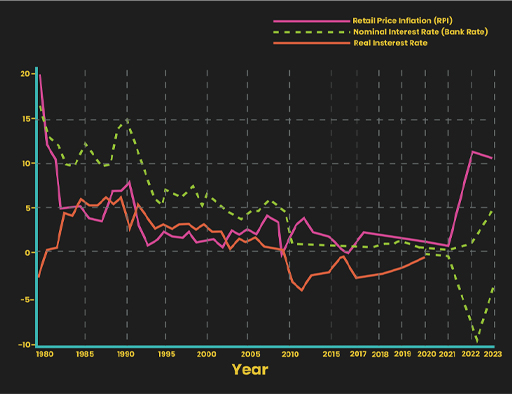1.3.4 Real interest rates

You explored earlier why it is important to take inflation into account when managing your investments. Unless there is no price inflation, the nominal return from an investment – the amount of cash paid to you – is different to its real return, in effect the value to you in terms of the goods it can buy.
Real interest rates are interest rates that have been adjusted to take inflation into account. Looking at the graph, you’ll see that when inflation is higher than the nominal interest rate, real interest rates are negative (as they were in 1980/1981 and again from 2010). Real interest rates are at zero when the rate of inflation and the nominal interest rates are the same, and they are positive when the nominal interest rate exceeds inflation.
Real interest rates were low in the 1990s and 2000s, falling from 7% in 1990 to just under 2% by 2004. Subsequently they fell further. By early 2015 the fall in the (nominal) official interest rate to the then historical low of 0.5%, combined with price inflation of 1.4% (as measured by the Retail Prices Index – RPI), resulted in a negative real interest rate of -0.9%. Indeed, low nominal rates of interest meant that the UK experienced negative real interest rates throughout the 2010s and, particularly, in the early 2020s.
So, if you earn a nominal rate of interest of 1.5% on your savings and price inflation is 2%, you are actually getting a real interest rate on your savings of -0.5% – a negative rate of return. Such a situation where real interest rates are negative is clearly adverse for savers. However it is good news for borrowers if the cost of borrowing is negative in real terms.
Unsurprisingly, the low interest rates offered on savings in recent years have encouraged some households to reduce their debts – particularly credit card debts which have relatively high interest rates – by reducing their savings balances.
